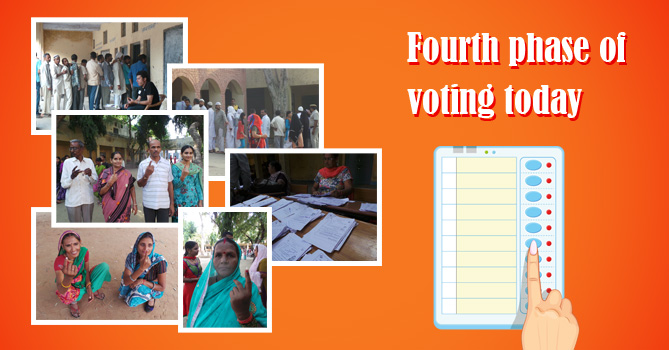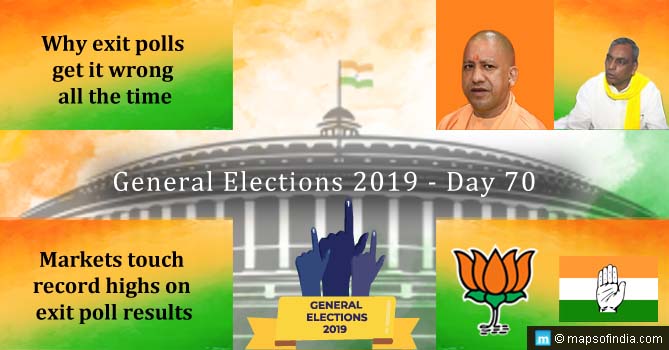 1.47 crore voters will cast their vote today during the 4th phase of voting. Voters across 7 districts will vote to elect 55 candidates to the 2015 Bihar Legislative Assembly. Out of 55 constituency seats, 7 are reserved for SC candidates.
1.47 crore voters will cast their vote today during the 4th phase of voting. Voters across 7 districts will vote to elect 55 candidates to the 2015 Bihar Legislative Assembly. Out of 55 constituency seats, 7 are reserved for SC candidates.
Voting will commence at 0700 hours and will close at 1700 hours for most constituencies. However, voting will close at 1500 hours at Sheohar, Riga, Runisaidpur, and Belsand constituencies, while at 8 other constituencies the voting shall close at 1600 hours.
The 5th and last round of polling will take place on Thursday 5 November. The results will be announced on Sunday 8 November.
Latest voter turnout report as on 1000 hours today
- West Champaran: 23.28%
- East Champaran: 18.32%
- Sheohar: 18.90%
- Sitamarhi: 16.34%
- Muzaffarpur: 21.15%
- Gopalganj: 18.43%
- Siwan: 15.53%
Phase total: 18.97%
The 7 districts holding the polls today are: West Champaran, East Champaran, Sheohar, Sitamarhi, Muzaffarpur, Gopalganj and Siwan
District: West Champaran
Assembly constituencies: Valmikinagar, Ramnagar (SC), Narkatiaganj, Bagaha, Lauriya, Nautan, Chanpatia, Bettiah, Sikta.
District: East Champaran
- Assembly constituencies: Raxaul, Sugauli, Narkatia, Harsidhi (SC), Govindganj, Kesariya, Kalyanpur, Pipra, Madhuban, Motihari, Chiraia, Dhaka.
District: Sheohar
- Assembly constituencies: Sheohar
District: Sitamarhi
- Assembly constituencies: Riga, Bathnaha, Parihar, Sursand, Bajpatti, Sitamarhi, Runisaidpur, Belsand.
District: Muzaffarpur
- Assembly constituencies: Gaighat, Aurai, Meenapur, Bochaha (SC), Sakra (SC), Kurhani, Muzaffarpur, Kanti, Baruraj, Paroo, Sahebganj.
District: Gopalganj
- Assembly constituencies: Baikunthpur, Barauli, Gopalganj, Kuchaikote, Bhorey (SC), Hathua.
District: Siwan
- Assembly constituencies: Siwan, Ziradei, Darauli (SC), Raghunathpur, Daraundha, Barhariya, Goriyakothi, Maharajganj.
Total Assembly seats in Phase-4: 55
- Total candidates : 776
- Male candidates: 719
- Women candidates: 57
Party-wise break-up of candidates
- BJP is fielding up 42 candidates, while HAM-S-4, RLSP-4 and LJP-5.
- JD(U) is fielding 21 candidates, RJD-26 and INC-8.
- BSP is fielding 53 candidates, CPI-21, CPM-9, NCP-9 and Independents-265.
The break-up of electors in the third phase of voting:
- Total electors: 1,47,39,120
General electors:
- Total: 1,47,23,034
- Male electors: 78,65,387
- Female electors: 68,57,218
- Third gender: 429
Service electors:
- Total: 16,086
- Male electors: 10,878
- Female electors: 5,208
- Third gender: 0
Total number of ASD electors: 7,64,380
First time electors within 18-19 years of age include:
- Total electors: 4,71,301
- Male electors: 2,93,731
- Female electors: 1,77,500
- Other: 70
Other details
- Total number of polling stations: 14,139
- Total number of polling station locations: 9,858
- Total number EVMs to be used: CU: 14,139; BU: 18,289
- Total number of polling staff to be deployed: 69,638
- Total number of CRPF & police personnel to be deployed (Companies): 1,163
- Total number of video cameras to be deployed: 1,153
- Total number of Helicopter/UAV to be deployed: 5
Will people overcome politics of hatred?
2015 Assembly elections will be remembered for the attempt by political parties to introduce communal polarization, bitterness, hate, and casteism amongst the voters in order to gain advantage for their own parties.
Bihar has always witnessed polarization of voters in the run up to elections on the basis of caste. Poll rigging, poll violence and voter intimidation has been part of the polling experience in the state.
This time, however, the Election Commission has done a wonderful job of ensuring that polls are conducted in a free and fair manner and without the traditional poll rigging, poll violence and voter intimidation. Barring a few minor incidents, the polling in all the phases thus far have been largely peaceful and without incident.
So how is 2015 any different from 2010 assembly poll campaign?
Political realignment:
In 2010, JD(U) was in an alliance with BJP and the main fight was between this alliance and that of RJD and their alliance partner LJP. The INC fought independently.
In 2015, JD(U) has joined hands with RJD and INC in a Grand Alliance, while the BJP has joined hands with LJP, RLSP and HAM-S that form the NDA.
Caste factor:
Bihar has always been deeply divided along caste lines and therefore, it has always expressed itself in the electoral space. Alliances are negotiated based on caste arithmetic and power sharing.
In 2010, the election saw JD(U) and RJD competing against each other for the same voter segment, with BJP gaining the most from this vote split. INC was the biggest loser after putting up 243 candidates but winning only 4 seats. INC has traditionally positioned itself as a secular party and was expected to get a large part of the Muslim and the backward class votes but that did not happen. In their case, the caste factor was never a factor.
In 2015, all parties have been guilty of trying to polarize the voter sentiment by playing the caste card and hyping up the threat and loss of opportunity for each caste. In 2010, caste was an election issue, but this time there has been a vicious attempt to play the caste card, irrespective of the subsequent consequence.
Communal card:
In 2010, the communal factor was minimal and one did not see overt attempt to polarize although one did see electoral gimmickry in the form of Lalu Prasad parading an Osama look-alike and so on. But beyond minor incidents, there was no major polarization attempt or communal disharmony invoked by any party or alliance.
2015 has witnessed a new low. BJP’s aggression towards winning in Bihar surpasses its previous campaign in 2010. His time, the stakes for the Party and the PM himself is high, and the political impact of these elections will determine the tone and scale of national politics. Therefore, it is this sense of urgency, bordering on desperation, that has seen a country’s Prime Minister take frontline responsibility for the first time, in becoming the face of the NDA alliance and aggressively campaigning in a state election.
In the run up, there have been a string of events that have vitiated the electoral atmosphere. It started with various controversial statements being made by right wing fringe elements, which was followed by the Dadri killing. The subsequent prolonged silence on part of the PM only gave the fringe elements within the party and outside of it, more opportunity to stoke controversy.
The beef debate raged nationally and soon its impact reached Bihar, with people like Lalu Prasad joining in the free-for-all. The net result has been a general sense of insecurity and polarization across the country, and especially in Bihar, where the voting process is underway.
This time around there is a lot of acrimony and bitterness amongst all parties and all must share the blame for this. The voters have been treated with utter disdain and with total contempt of their self-respect and intelligence. Rally after rally netas have been making all kinds of speeches that range from the ridiculous to downright insult. Name calling has always been a part of the Indian electoral process but personal attacks have taken politics to a new low.
The elections in Bihar will soon be over and one or the other alliance will form the next government. While nets will move on to their next hunting ground, it’s the local people who will be left to deal with the aftermath of polarization.
It is the simple folk who have to carry on the daily struggle to earn a living, but dealing with the politics of hatred, is a challenge they will have to face themselves. That’s the price one has to pay for irresponsible democracy.





